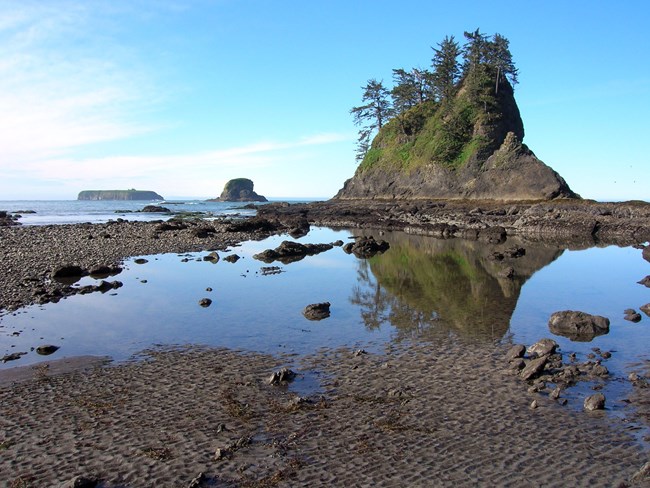
NPS photo
Olympic National Park encompasses 922,651 acres (373,397 ha) in the center of Washington's Olympic Peninsula and includes a 60-mile strip of wilderness coastline on the Pacific Ocean. Ranging from sea level to almost 8,000 ft (2,435 m), Olympic National Park encompasses a broad gradient of habitats.
The Olympic Mountains intercept moisture-laden Pacific winds, resulting in a significant rainshadow effect. Olympic National Park is the wettest spot in the conterminous United States; the west slopes of Mount Olympus receive about 200 inches (508 cm) of precipitation per year, while less than 34 miles to the east, precipitation is less than 20 inches (50.3 cm) per year. Park ecosystems range from the rich intertidal zone, to rainforests, montane forests, alpine meadows, and glaciers. Temperate rainforests blanket the western slopes of the mountains, while alpine tundra conditions prevail in the dry, northeast section of the park.
The North Coast and Cascades Network provides natural resource inventory and monitoring information to help parks make effective, science-based management decisions. Inventories have been completed for birds, fish, mammals, reptiles & amphibians, and vascular plants (see species lists further down the page). Maps and reports detailing Olympic National Park's vegetation are complete and are in progress for soils and geologic resources.
For more information about Olympic National Park, visit the Park website.
Monitored Here
ClimateElk*
Fish Assemblages**
Forest Vegetation***
Glaciers
Intertidal
Landbirds
Landscape Change
Mountain Lakes
Subalpine Vegetation
Water Quality
* Elk monitoring has been suspended with protocol redesign pending.
** Fish monitoring was conducted from 2005 thorugh 2011.
*** Forest monitoring is intermittent due to funding limitations.
Publications
Monitoring Reports
Source: NPS DataStore Saved Search 558 (results presented are a subset). To search for additional information, visit the NPS DataStore.
Source: NPS DataStore Saved Search 552 (results presented are a subset). To search for additional information, visit the NPS DataStore.
Source: NPS DataStore Saved Search 556 (results presented are a subset). To search for additional information, visit the NPS DataStore.
Source: NPS DataStore Saved Search 555 (results presented are a subset). To search for additional information, visit the NPS DataStore.
Source: NPS DataStore Saved Search 566 (results presented are a subset). To search for additional information, visit the NPS DataStore.
Source: NPS DataStore Saved Search 3691 (results presented are a subset). To search for additional information, visit the NPS DataStore.
Source: NPS DataStore Saved Search 553 (results presented are a subset). To search for additional information, visit the NPS DataStore.
Source: NPS DataStore Saved Search 567 (results presented are a subset). To search for additional information, visit the NPS DataStore.
Source: NPS DataStore Saved Search 639 (results presented are a subset). To search for additional information, visit the NPS DataStore.
Source: NPS DataStore Saved Search 640 (results presented are a subset). To search for additional information, visit the NPS DataStore.
Inventory Reports
Source: NPS DataStore Collection 531 (results presented are a subset). To search for additional information, visit the NPS DataStore.
Monitoring Protocols
Source: NPS DataStore Collection 7780 (results presented are a subset). To search for additional information, visit the NPS DataStore.
Synthesis, Trend, and Journal Publications
Source: NPS DataStore Saved Search 3605 (results presented are a subset). To search for additional information, visit the NPS DataStore.
Select a Park:
Select a Species Category (optional):
Visit NPSpecies for more comprehensive information and advanced search capability. Have a suggestion or comment on this list? Let us know.
Last updated: August 24, 2023
